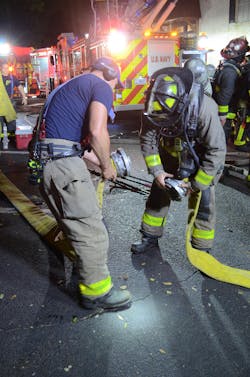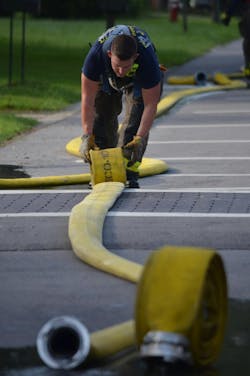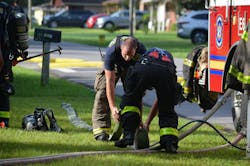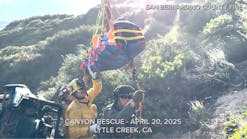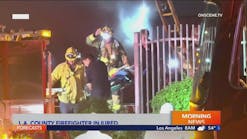The fire service has advanced how it fights and suppresses fire significantly. One big advancement is the use of fire hose to deliver water from what once was considered a plug to now a fire hydrant or from tank water. In the early days, it was buckets, then steamers and plugs using short sections of hose. Then came the two-piece company, with a steamer/pumper and a hose wagon. Now, fire engines have a booster tank, with most urban departments carrying 500 gallons of water and some suburban departments carrying 1,000 gallons or more. Some departments that have a jurisdiction that doesn’t have sufficient hydrants also have tenders that carry thousands of gallons of water that can be delivered directly to the fire scene. All of this has decreased the time that it takes to get water on the fire and provide better fire protection.
Regardless of whether it’s tank water or hydrant water as the supply, fire hose is the critical component that delivers water to a pump, which will increase the pressure properly to deliver the water through attack fire hose for an effective fire stream that will overwhelm the heat.
Fire hose is the foundation of water delivery. It provides water from one engine to another via booster tank water supply availability or from a hydrant to an engine. This fire hose is referred to as supply hose and, historically, was 2½, 3 or 5 inches. With it, the fire engine can pump the water at the proper pressure through attack fire hose; historically, this was 1½ or 2½ inches.
Fire hose is required to create and deliver a fire stream for fire attack/suppression. Understanding the size of hose that’s necessary for either supplying a fire engine or to deliver the amount of water that’s required to overwhelm the fire to accomplish rapid extinguishment is important. Yes, size matters, but this doesn’t always mean bigger is better, because what the hose will be used to accomplish and what staffing is using it are critical elements of the determination.
Trying to back stretch/hand stretch large-diameter hose (LDH), regardless of whether it is 4 inches or 5 inches, is time-consuming and requires significant staffing if the distance is a few hundred feet. This would be a situation where utilizing 3-inch hose is the supply line of choice; it would allow only one or two firefighters to rapidly back stretch/hand stretch hundreds of feet without issue, to achieve water supply, to provide another engine or to provide a water supply to an aerial device for master stream operations.
Size and construction
Sometimes, the size that’s advertised and/or assigned to a specific brand/model of fire hose might not be exactly accurate in regard to the actual size of the interior diameter of the hose. For example, hose manufacturers advertise hose as 1¾ inches when it actually is larger and might be 1.88 inches. This has been done for all size hose to market in terms of having lower friction loss.
Another issue is how the hose is manufactured in regard to design and exterior construction. Some hose actually stretches under higher pressures, which increases the interior diameter.
Allowing a higher flow and/or reduced friction loss doesn’t align with hydraulic formulas that are used to determine friction loss for a given size. Hydraulic formulas are based on pipe size, which doesn’t change. The pump hydraulic formulas or accepted flows that are based on past educational curriculum that are taught throughout the fire service sometimes can be off when used with hose that’s manufactured today. So, it’s important that fireground commanders understand what their fire hose can and can’t do in regard to water supply and water delivery for fire attack.
Understand the options
Fire attack packages require the proper fire hose for a given flow rate and the nozzle that’s used. The fire service has effected significant changes in the past 20 years in regard to fire stream flows, fire stream selection and types of nozzles. This has been a good improvement toward a more efficient fire attack for suppressing today’s and tomorrow’s fires. That said, too many times, the size, brand and model were overlooked or underestimated.
The options today require understanding that most hose manufacturers make low-bid/basic fire hose, high-bid/high-quality hose and, usually, something in the middle. There can be nearly a 50 percent difference in friction loss that’s based on model difference within the same advertised size hose. So, make sure that you get what you need and know what it will and won’t do.
Hose creep
I ran rather extensive flow tests in 2007 with 2½- and 3-inch fire hose. I utilized two different flow meters as well as a pitot gauge to confirm flows. I also took a lot of photographs during the process.
More than 500 gallons per minute were pushed through 500 feet of 2½-inch hose to flow the 500-gpm Rapid Attack Monitor (RAM) that had a 1-3/8-inch tip flowing 500 gpm at 80 psi tip pressure. Nearly 1,000 gpm was able to be flowed with an increase to 3-inch hose at 500 feet (2-inch tip). When using hydraulic calculations for 2½- and 3-inch hose and staying at a maximum of 250 psi pump discharge pressure, this same performance isn’t possible.
A maximum that was based on annual testing of 250 psi for five minutes was set. This was the start of what created significant questions by others in the fire service. This led to a deeper dive into how and why this amount of water was able to be flowed through 2½- and 3-inch hose. The result that emerged from the findings was hose creep/hose stretching under higher pressures that increased the interior diameter. This lowered the friction loss and allowed a larger flow.
Critical velocity
Some things have been taught or interpreted differently than actually were intended. An example would be critical velocity length and friction loss.
Critical velocity is the ideal maximum flow before the friction loss rapidly increases. An example is 2½ inch critical velocity being 250 gpm, but you can flow 1,000 gpm through a 2-inch tip. Thus, you definitely can flow a lot more than the critical velocity of 250 gpm. The understanding must be what you can do with a certain distance and pump discharge pressure. What can you flow through a supply line that allows a 250 psi pump discharge pressure? You must understand that the psi will drop as it moves down the line. Therefore, the pressure won’t be an issue when the water arrives at its final destination. Sometimes, it’s more tactically proficient to push water under a higher pressure through a smaller hose that can be stretched faster and with fewer firefighters.
A tactical option
Fire hose replaced the bucket brigade, but all of us in the fire service must conTinue to enhance how we use all of our options in regard to fire hose size, brand and model. In other words, what fire hose we use matters. So does understanding the different qualities that are available based on size, exterior weave and inner liner.
We must consider 2½- and 3-inch hose for water supply and water delivery in our attack package setups. More times than not, 3-inch hose will be a better tactical option at most fires than LDH. This is based on weight of hose, pressures that can be pumped, and distances that one firefighter can stretch it and/or move it when the hose blocks access at a fire—even just picking it up, rolling it and packing it on the apparatus.
Hose size matters, and sometimes smaller is the best tactical option for fireground command success.

Curt Isakson
Curt “Ike” Isakson is a 30-plus-year veteran of the fire service. He currently is a battalion chief for Escambia County, FL, Fire Rescue, where he has worked for the past 23 years. Isakson previously worked nine years for the Pensacola, FL, Fire Department, where he was assigned as a company officer on Heavy Rescue 31. His fire service experience started at a young age as a junior firefighter with the Midway, FL, Fire District; he rose through the ranks to captain. Isakson's identification of the need for a series of special-interest fire conferences spawned the development of County Fire Tactics, which covers officer development, command officers, water on fire, high-rise operations, and leadership and tactics.

